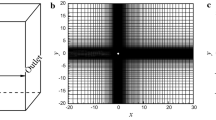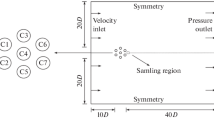Abstract
The features of the wake behind a uniform circular cylinder atRe=200, which is just beyond the critical Reynolds number of 3-D transition, are investigated in detail by direct numerical simulations by solving 3-D incompressible Navier-Stokes equations using mixed spectral-spectral-element method. The high-order splitting algorithm based on the mixed stiffly stable scheme is employed in the time discretization. Due to the nonlinear evolution of the secondary instability of the wake, the spanwise modes with different wavelengths emerge. The spanwise characteristic length determines the transition features and global properties of the wake. The existence of the spanwise phase difference of the primary vortices shedding is confirmed by Fourier analysis of the time series of the spanwise vorticity and attributed to the dominant spanwise mode. The spatial energy distributions of various modes and the velocity profiles in the near wake are obtained. The numerical results indicate that the near wake is in 3-D quasi-periodic laminar state with transitional behaviors at this supercritical Reynolds number.
Similar content being viewed by others
References
Williamson CHK. The natural and forced formation of spot-like dislocations in the transition of a wake.J Fluid Mech, 1992, 243: 393–441
Zhang HQ, Fey U, Noack BR, et al. On the transition of the cylinder wake.Phys Fluids, 1995, 7(4): 779–794
Thompson M, Hourigan K, Sheridan J. Three-dimensional instabilities in the wake of a circular cylinder.Exp Therm Fluid Sci, 1996, 12(2): 190–196
Persillon H, Braza M. Physical analysis of the transition to turbulence in the wake of a circular cylinder by three-dimensional Navier-Stokes simulation.J Fluid Mech, 1998, 365: 23–88
Yu CW. On the features of the three-dimensional transition in the wake of a circular cylinder. [PhD Thesis]. Beijing: Institute of Mechanics, CAS, 1998 (in Chinese)
Ling GC, Yu CW, Xiong ZM. The nonlinear features of the wake transition behind a circular cylinder. In: Lian QX & Kiga M eds. Proceeding of the Third China-Japan Workshop on Turbulent Flow, Beijing, 1998-10-03-11-04, Beijing: Beijing Univ of Aero & Astro Press, 1998
Barkley D, henderson RD. Three-dimensional Floquet stability analysis of the wake of a circular cylinder.J Fluid Mech, 1996, 322: 215–241
henderson RD. Nonlinear dynamics and pattern formation in turbulent wake transition.J Fluid Mech, 1997, 352: 65–112
Karniadakis GE, Triantafyllou GS. Three-dimensional dynamics and transition to turbulence in the wake of bluff objects.J Fluid Mech, 1992, 238: 1–30
Patera AT. A spectral element method for fluid dynamics: Laminar flow in a channel expansion.J Comput Phys, 1984, 54(3): 468–488
Korczak KZ, Patera AT. An isoparametric spectral element method for solution of the Navier-Stokes equations in complex geometry.J Comput Phys, 1986, 62(2): 361–382
Karniadakis GE, Israeli M, Orszag SA. High-order splitting methods for incompressible Navier-Stokes equations.J Comput Phys, 1991, 97(2): 414–443
Roshko A. On the development of turbulent wakes from vortex streets. NACA Rep. 1191, 1954
Williamson CHK. The existence of two stages in the transition to three dimensionality of a cylinder wake.Phys Fluids, 1988, 31(11): 3165–3167
Konig M. The fine structure in the Strouhal-Reynolds number relationship of the laminar wake of a circular cylinder.Phys Fluids 1990, 2(9): 1607–1614
Hammache M, Gharib M. An experimental study of the parallel and oblique vortex shedding from circular cylinders.J Fluid Mech, 1991, 232: 567–590
Norberg C. An experimental investigation of the flow around a circular cylinder: influence of aspect ratio.J Fluid Mech, 1994, 258: 287–316
Henderson RD. Details of the drag curve near the onset of vortex shedding.Phys Fluids, 1995 7(9): 2102–2121
Author information
Authors and Affiliations
Additional information
The project supported by the State Key Fundamental Research Project of “Large Scale Scientific Computation Research” (G199903281)
Rights and permissions
About this article
Cite this article
Jun, X., Guocan, L. & Keqin, Z. Features of the supercritical transition in the wake of a circular cylinder. Acta Mech Sinica 18, 567–580 (2002). https://doi.org/10.1007/BF02487959
Received:
Revised:
Issue Date:
DOI: https://doi.org/10.1007/BF02487959




